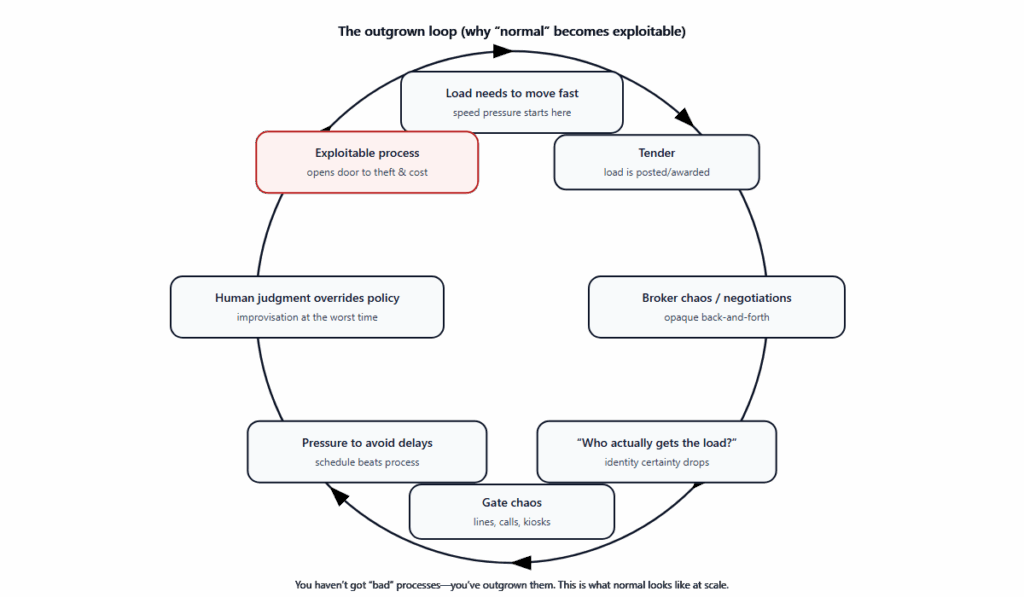Freight’s Double Problem—and the On-Trailer Answer

It’s 7:12 a.m. at Gate 3. Steve pulls up with his tractor; the paperwork pinball has been going since dawn—broker emails, updated PDFs, a phone that won’t stop. The line’s growing, the system is lagging, and Lina wants the dock back on schedule, so she does what busy yards do under pressure: she waves Steve through.
Lucky break—this time it really was Steve.
Down the road, a meat processor in Tennessee wasn’t as lucky: a fake trucking company picked up ~80,000 lbs of beef (≈$350,000) and vanished. You know these stories. They’re not one-offs; they’re part of a wider surge in identity-based theft and fictitious pickups across North America.
Why we keep landing in this spot
It’s not that we have “bad processes.” We’ve outgrown the ones that used to work. We digitized forms and added dashboards, but custody policy still lives in inboxes and calls. At today’s speed and scale, the pattern repeats:

None of that makes Lina negligent. It makes her normal—and normal is exactly what organized theft relies on. The loop doesn’t just waste minutes; it multiplies cost and risk. Inefficiency invites improvisation; improvisation creates openings; openings get exploited.
You shouldn’t need a space-program budget to move dry goods. If the plan is ‘throw money at alerts,’ ask the CFO for NASA-level spend—then, when they stop blinking, try Level5Freight.
Philosophy behind Level5Freight
We believe security policy belongs on the trailer. Not in an email. Not on a clipboard. On the equipment—enforced quietly, every time—so neither luck nor a heroic phone call is required when the line is long.
There’s a second truth: you shouldn’t need moon-shot budgets to get smart equipment. The fix is updating the protocol so modern tools remove friction and close gaps.
What if we married digital freight matching, the price efficiency of exchanges, and mechanical control from on-trailer devices? You get one-click, cost-efficient, secure delivery.
Level5Freight = a rebuilt freight protocol
Instead of patching risk with audits and alarms, we rewrote the rules of engagement:
- Automated, private matching. No open load boards. Level5Freight matches fairly and privately, splitting the midpoint between shipper and carrier.
- Comms only where needed. Only the parties on the load see the conversation. No public, spoofable breadcrumbs.
- Smart trailers by design. Even without a network, the trailer knows what’s allowed—and blocks everything else.
- Prevention over detection. Out-of-policy actions aren’t merely flagged. They’re blocked.
Under the hood, Level5Freight runs on Admiral, our on-trailer security suite:
- Admiral Lock is interior-mounted (inaccessible) with a virtual seal. The shipper names who can “break the seal”; if authorization isn’t met, the lock won’t release.
- Admiral Immobilizer locks the parking brakes so the unit can’t move. It’s engineered not to activate in motion; it would require five independent systems—across the tractor and Admiral—to fail before that could even be possible. That’s a higher safety bar than everyday brake-leak risks.
- Admiral enforces policy on the equipment, going far beyond GPS alerts.
Level5Freight itself includes load matching plus built-in YMS/TMS (and integrates cleanly with your 3P tools). When a match happens, policy is handed to Admiral, so trailer/tractor, driver, and YMS/TMS all enforce the same truth. Auto check-in is just a byproduct of alignment.
How it all fits together
1) Shipper sets price + security.
Post the rate you’re happy with and your security posture (TSR-aware if you like, but managed so it’s hands-off). Set the schedule.
2) Carrier sets price + availability.
Post a floor you’re happy with. Admiral automates equipment/driver availability from compliant smart trailers.
3) Midpoint match—no back-and-forth.
Matched at the midpoint. No last-minute haggling threads. No public, spoofable crumbs.
4) Policy moves to the trailer.
Match accepted → authorization (driver + tractor + pickup window + site geofence) is sent to Admiral. From here, the trailer enforces policy: doors stay shut and the unit won’t release unless conditions align.
5) Systems handshake—quietly.
The trailer talks with our built-in or your own TMS/YMS. Yard already knows who Steve is, what he’s driving, the load he’s authorized for, and where he is. The dock knows when to start loading. (Optional: with integration, dock doors won’t open until the correct unit is parked.)
6) The yard and dock just… work.
On load complete, docs attach automatically; Admiral locks + arms. Steve rolls out. Everyone’s in sync because the equipment is the source of truth.
Short, honest math (illustrative)
Spread removed (15% of $1,800 × 25): ≈ $6,750/week
Admin time saved (30 min × 25 @ $35/hr): ≈ $437/week
Platform fee ($25 × 25): $625/week
Net direct: ≈ $6,562/week (≈ $341,224/year) — before theft-risk reduction
A quick word on TSR (and how Admiral compares)
If TSR rings a bell: it’s the TAPA’s Trucking Security Requirements with 3 levels – the lowest of which allows self-certification, and the highest requires independent 3P audit. It’s focused on monitoring/response and documented procedures. Admiral meets that bar—and goes further—by preventing out-of-policy events at the trailer itself (identity + time + location must align before access), which reduces the need to “chase” alerts after the fact.
Why this is safer (and calmer)
When policy lives on the trailer, the riskiest moment of the day is no longer the most chaotic. Lina doesn’t need to wave people through on faith. Steve doesn’t need to prove he’s not Bob. And the CFO doesn’t need paramedics on speed-dial.
Learn more (and model your lane)
Book a 20-minute workflow consult. We’ll map your lanes, hand you ROI + risk math, and walk the on-trailer policy from tender to locked doors—end to end.
Stay Connected
Want more insights like this? Follow Level5Fleet for future articles, freight industry trends, and updates on building a smarter, more secure supply chain:
🔗 LinkedIn
🐦 X: @Level5fleet
📘 Facebook
📸 Instagram
The Future of Tractor-Trailer Security